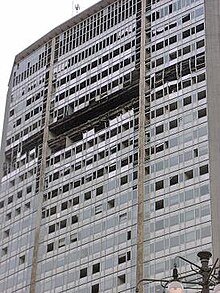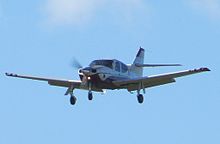| This article needs additional citations for verification. Please help improve this article by adding citations to reliable sources. Unsourced material may be challenged and removed. Find sources: "2002 Pirelli Tower airplane crash" – news · newspapers · books · scholar · JSTOR (August 2022) (Learn how and when to remove this message) |
| This article may be excessively based on contemporary reporting. Please use newer secondary sources; articles on events that lack lasting impact may be merged, redirected, or deleted. (March 2024) (Learn how and when to remove this message) |
 Impact zone in the Pirelli Tower shortly after the crash. Impact zone in the Pirelli Tower shortly after the crash. | |
| Accident | |
|---|---|
| Date | 18 April 2002; 22 years ago (2002-04-18) |
| Summary | Collision with building |
| Site | Pirelli Tower, Milan, Italy 45°29′05″N 9°12′05″E / 45.48472°N 9.20139°E / 45.48472; 9.20139 |
| Aircraft | |
| Aircraft type | Rockwell Commander A112 |
| Aircraft name | Rockwell Commander 112 |
| Operator | Private |
| Registration | HB-NCX |
| Flight origin | Locarno Airport, Magadino, Switzerland |
| Crew | 1 |
| Fatalities | 1 |
| Survivors | 0 |
On 18 April 2002, at 17:48 (local time), a small single-engine Rockwell Commander 112 crashed into the upper floors of the Pirelli Tower in Milan, Italy, for reasons still unclear. The crash killed the pilot and two others in the building. Sixty more people sustained injuries in the building and on the ground.
The crash raised fears of a terrorist attack because of the similarities with the September 11 attacks, which had occurred seven months earlier. A subsequent investigation ruled out terrorism as a motive.
Incident

The airplane, piloted by 65-year-old Luigi Fasulo, took off from Locarno Airport in Magadino, Switzerland, eighteen minutes before the crash. Later, as the airplane flew over Milan, Italy, the pilot radioed to the control tower at Linate Airport that there was a problem with the retractable landing gear. The tower began arranging an emergency landing. The plane crashed into the upper floors of the Pirelli Tower. The vibration of the impact caused shop windows to break and littered the surroundings with debris and glass in offices. The pilot and two others present inside the building died.
Between thirty and forty people were taken to the hospital with moderate injuries, while fire-fighters contained the fire that resulted from the crash. Immediately after the crash, the nearby Milan central railway station, metro station and the Linate airport were closed.
Investigation
Italian officials conducted an investigation after the crash. The cause of the crash was never exactly determined or confirmed, but the most plausible reason is an accident or a suicide. The pilot had been the victim of a scam that brought him close to bankruptcy, so the possibility of a public suicide is plausible.
Aftermath
The crash aroused fears of a terrorist attack since it occurred seven months after the September 11 attacks. Because of this, stock markets around the United States and Europe fell sharply and business trading in Milan was suspended. The fears ended when investigators concluded that the crash was not an act of terrorism.
References
- "Three dead as plane hits Milan's tallest building". CNN. 19 April 2002. Retrieved 19 April 2014.
- "Investigators:Intentional or accidental crash?". Corriere Della Sera.it. 20 April 2002. Retrieved 12 November 2016.
- Janine Yagielski: New Yorkers' first reaction: 'Not again' Archived 14 April 2008 at the Wayback Machine, CNN, 19 April 2002. URL Accessed: 4 August 2006
- BBC News: Markets rattled by Milan plane crash, 18 April 2002. URL Accessed: 4 August 2006
See also
- 1945 Empire State Building Crash
- 2002 Tampa airplane crash
- October 11, 2006 New York City plane crash